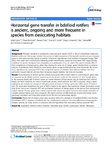Horizontal gene transfer in bdelloid rotifers is ancient, ongoing and more frequent in species from desiccating habitats
| dc.contributor.author | Eyres, I | |
| dc.contributor.author | Boschetti, Chiara | |
| dc.contributor.author | Crisp, A | |
| dc.contributor.author | Smith, TP | |
| dc.contributor.author | Fontaneto, D | |
| dc.contributor.author | Tunnacliffe, A | |
| dc.contributor.author | Barraclough, TG | |
| dc.date.accessioned | 2017-06-02T10:16:29Z | |
| dc.date.available | 2017-06-02T10:16:29Z | |
| dc.date.issued | 2015-12 | |
| dc.identifier.issn | 1741-7007 | |
| dc.identifier.issn | 1741-7007 | |
| dc.identifier.other | 90 | |
| dc.identifier.uri | http://hdl.handle.net/10026.1/9406 | |
| dc.description.abstract |
BACKGROUND: Although prevalent in prokaryotes, horizontal gene transfer (HGT) is rarer in multicellular eukaryotes. Bdelloid rotifers are microscopic animals that contain a higher proportion of horizontally transferred, non-metazoan genes in their genomes than typical of animals. It has been hypothesized that bdelloids incorporate foreign DNA when they repair their chromosomes following double-strand breaks caused by desiccation. HGT might thereby contribute to species divergence and adaptation, as in prokaryotes. If so, we expect that species should differ in their complement of foreign genes, rather than sharing the same set of foreign genes inherited from a common ancestor. Furthermore, there should be more foreign genes in species that desiccate more frequently. We tested these hypotheses by surveying HGT in four congeneric species of bdelloids from different habitats: two from permanent aquatic habitats and two from temporary aquatic habitats that desiccate regularly. RESULTS: Transcriptomes of all four species contain many genes with a closer match to non-metazoan genes than to metazoan genes. Whole genome sequencing of one species confirmed the presence of these foreign genes in the genome. Nearly half of foreign genes are shared between all four species and an outgroup from another family, but many hundreds are unique to particular species, which indicates that HGT is ongoing. Using a dated phylogeny, we estimate an average of 12.8 gains versus 2.0 losses of foreign genes per million years. Consistent with the desiccation hypothesis, the level of HGT is higher in the species that experience regular desiccation events than those that do not. However, HGT still contributed hundreds of foreign genes to the species from permanently aquatic habitats. Foreign genes were mainly enzymes with various annotated functions that include catabolism of complex polysaccharides and stress responses. We found evidence of differential loss of ancestral foreign genes previously associated with desiccation protection in the two non-desiccating species. CONCLUSIONS: Nearly half of foreign genes were acquired before the divergence of bdelloid families over 60 Mya. Nonetheless, HGT is ongoing in bdelloids and has contributed to putative functional differences among species. Variation among our study species is consistent with the hypothesis that desiccating habitats promote HGT. | |
| dc.format.extent | 90- | |
| dc.format.medium | Electronic | |
| dc.language | en | |
| dc.language.iso | eng | |
| dc.publisher | Springer Science and Business Media LLC | |
| dc.subject | Adaptation | |
| dc.subject | Bdelloid rotifers | |
| dc.subject | Evolution | |
| dc.subject | Horizontal gene transfer | |
| dc.subject | Lateral gene transfer | |
| dc.subject | Metazoans | |
| dc.title | Horizontal gene transfer in bdelloid rotifers is ancient, ongoing and more frequent in species from desiccating habitats | |
| dc.type | journal-article | |
| dc.type | Journal Article | |
| dc.type | Research Support, Non-U.S. Gov't | |
| plymouth.author-url | https://www.webofscience.com/api/gateway?GWVersion=2&SrcApp=PARTNER_APP&SrcAuth=LinksAMR&KeyUT=WOS:000364118600001&DestLinkType=FullRecord&DestApp=ALL_WOS&UsrCustomerID=11bb513d99f797142bcfeffcc58ea008 | |
| plymouth.issue | 1 | |
| plymouth.volume | 13 | |
| plymouth.publication-status | Published | |
| plymouth.journal | BMC Biology | |
| dc.identifier.doi | 10.1186/s12915-015-0202-9 | |
| plymouth.organisational-group | /Plymouth | |
| plymouth.organisational-group | /Plymouth/Faculty of Science and Engineering | |
| plymouth.organisational-group | /Plymouth/Faculty of Science and Engineering/School of Biological and Marine Sciences | |
| plymouth.organisational-group | /Plymouth/REF 2021 Researchers by UoA | |
| plymouth.organisational-group | /Plymouth/REF 2021 Researchers by UoA/UoA06 Agriculture, Veterinary and Food Science | |
| plymouth.organisational-group | /Plymouth/Users by role | |
| plymouth.organisational-group | /Plymouth/Users by role/Academics | |
| dc.publisher.place | England | |
| dcterms.dateAccepted | 2015-10-20 | |
| dc.identifier.eissn | 1741-7007 | |
| dc.rights.embargoperiod | No embargo | |
| rioxxterms.funder | Biotechnology and Biological Sciences Research Council | |
| rioxxterms.identifier.project | Eighty million years without sex: the role of genome structure in bdelloid rotifers | |
| rioxxterms.versionofrecord | 10.1186/s12915-015-0202-9 | |
| rioxxterms.licenseref.uri | http://www.rioxx.net/licenses/all-rights-reserved | |
| rioxxterms.licenseref.startdate | 2015-11-04 | |
| rioxxterms.type | Journal Article/Review | |
| plymouth.funder | Eighty million years without sex: the role of genome structure in bdelloid rotifers::Biotechnology and Biological Sciences Research Council |


